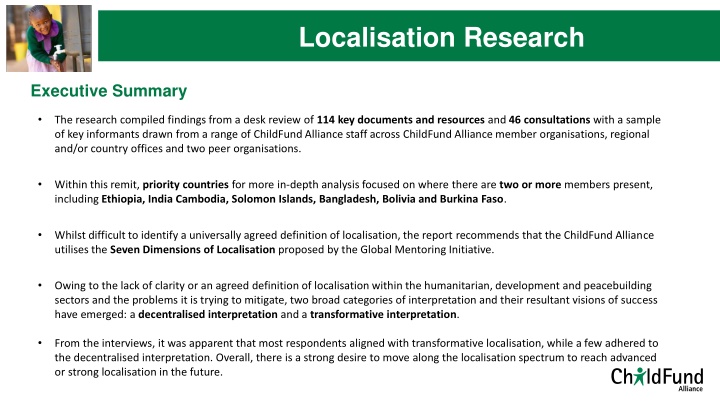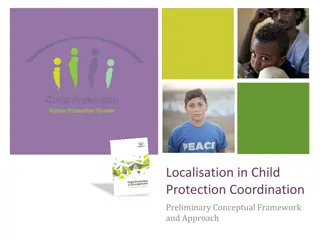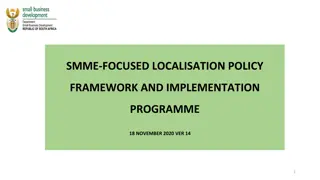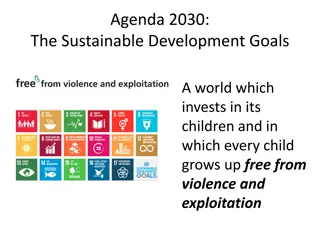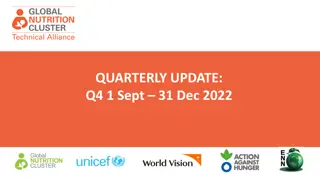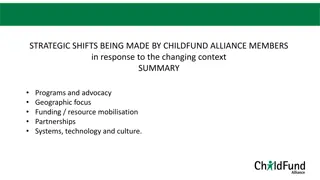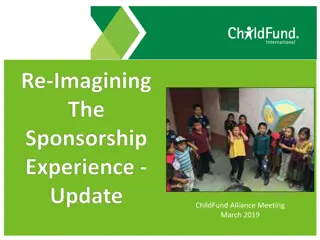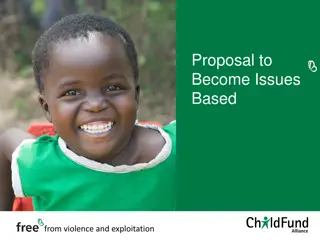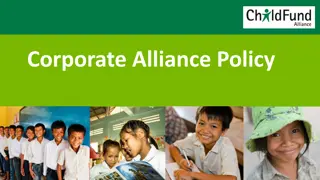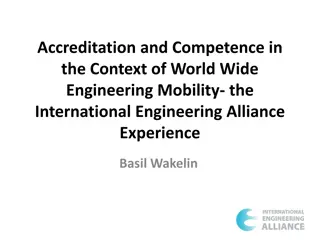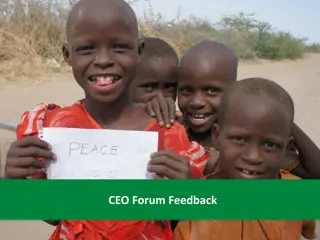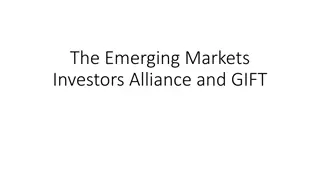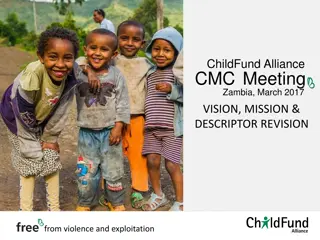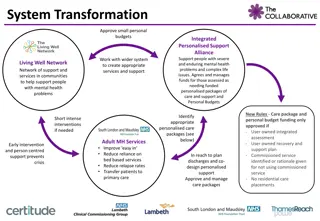Insights on Localisation Trends in ChildFund Alliance
Research findings on localisation trends in ChildFund Alliance reveal a strong desire for transformative localisation, with recommendations for utilising the Seven Dimensions of Localisation. Significant macro trends, operational models, and the impact of COVID-19 are discussed, along with recommendations for capacity strengthening among local partners.
Download Presentation

Please find below an Image/Link to download the presentation.
The content on the website is provided AS IS for your information and personal use only. It may not be sold, licensed, or shared on other websites without obtaining consent from the author.If you encounter any issues during the download, it is possible that the publisher has removed the file from their server.
You are allowed to download the files provided on this website for personal or commercial use, subject to the condition that they are used lawfully. All files are the property of their respective owners.
The content on the website is provided AS IS for your information and personal use only. It may not be sold, licensed, or shared on other websites without obtaining consent from the author.
E N D
Presentation Transcript
UN Representation Localisation Research Executive Summary The research compiled findings from a desk review of 114 key documents and resources and 46 consultations with a sample of key informants drawn from a range of ChildFund Alliance staff across ChildFund Alliance member organisations, regional and/or country offices and two peer organisations. Within this remit, priority countries for more in-depth analysis focused on where there are two or more members present, including Ethiopia, India Cambodia, Solomon Islands, Bangladesh, Bolivia and Burkina Faso. Whilst difficult to identify a universally agreed definition of localisation, the report recommends that the ChildFund Alliance utilises the Seven Dimensions of Localisation proposed by the Global Mentoring Initiative. Owing to the lack of clarity or an agreed definition of localisation within the humanitarian, development and peacebuilding sectors and the problems it is trying to mitigate, two broad categories of interpretation and their resultant visions of success have emerged: a decentralised interpretation and a transformative interpretation. From the interviews, it was apparent that most respondents aligned with transformative localisation, while a few adhered to the decentralised interpretation. Overall, there is a strong desire to move along the localisation spectrum to reach advanced or strong localisation in the future.
UN Representation Grant Support Committee What the report explored Significant macro trends on the horizon, which must be taken into account including the existential funding challenges for INGOs, the shifts in power globally and domestically; and rising forced displacement. How ChildFund Alliance members define local partners . Localisation trends among some of the major donors including: a strong shift towards localisation; preference to work directly with local partners; high expectations regarding compliance, accountability and transparency; reductions in indirect cost recovery allowances; and high expectations that ChildFund Alliance members will strengthen capacity of local partners The types of operational models within the ChildFund Alliance, including a discussion of some of the urgent issues raised by interviewees that are brought to the foreground by localisation and the above macro trends: the Child Sponsorship model and NGO-isation - it is time for a reset; competition for grants: the attraction of local funding - are we competing with local partners; and the private sector and ethical business principles. Priority areas for capacity strengthening among ChildFund Alliances local partners. The impact of COVID19 on ways of working in the ChildFund Alliance.
UN Representation Grant Support Committee Recommendations from Consultant 34 recommendations were made, phased over a 24 month period including: Phase 1 (months 1-6); Phase 2 (months 7-12); and Phase 3 (months 13-24). Recommendations are targeted at whole-of-Alliance level. Recognition that the research did not include consultations with a cross-section of ChildFund Alliance s local partners and other local actors - so it is useful to consider this study and report as a first step of a longer and more-in depth process of meaningful engagement on localisation. In order to take the localisation agenda forward in a horizontal structure, a key recommendation incudes the convening of a localisation working group of colleagues drawn from the different members of the Alliance and regions. Closing advice on the potential implications of localisation include: rationalise where the ChildFund Alliance works globally, regionally and at country level; develop multi-member country and/or regional strategies that ensure complementarity; reconfigure our roles and responsibilities as INGOs as i) catalysts and connectors, ii) technical experts iii) facilitators, coaches and mentors iv) multi-level advocates v) fundraisers; and conduct further work on key themes relevant to transformative localisation, specifically i) explore your expertise in humanitarian response, disaster risk reduction, climate change, resilience and environment ii) explore the linkages between child sponsorship models, cash transfers and social protection systems in the triple nexus; and iii) explore the implications of the greater use of digital technology in the ChildFund Alliance.
UN Representation Grant Support Committee Recommendations from GSC for consideration The ChildFund Alliance Grants Support Committee (GSC) had the chance to review the draft report and provide feedback to the consultant, much of which has been incorporated into the final report. At the same time, further areas of feedback that were not included either due to timing limitations or to ensure the report and its subsequent recommendations remain independent are highlighted below. Whilst the report makes a clear and strong argument for transformative transformation, a third possible option (and subsequent implications) to consider is a blended model that is transformative in terms of intent and end goal, but includes elements of a decentralised model (e.g. like Plan, Action Aid, WVI). Recommendations 3-9 should allow for i) a specific focus on exploring culture and identify as part of the localisation picture; and ii) exploring what localisation means in practical terms for our ways of working with young people/programming with young people. Recognising the time and resourcing required for developing country (or regional) strategies, immediate priority could be given to ensuring an alignment or commonality of approaches. Recognising it may be ambitious to develop an Alliance wide position paper on localisation in the Phase 1 (first six months) timeframe, this could be moved to Phase 2 (7-12 months).
